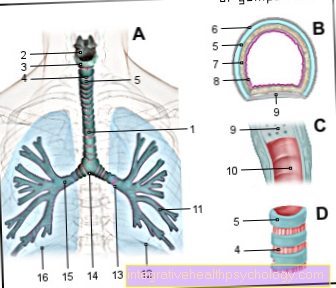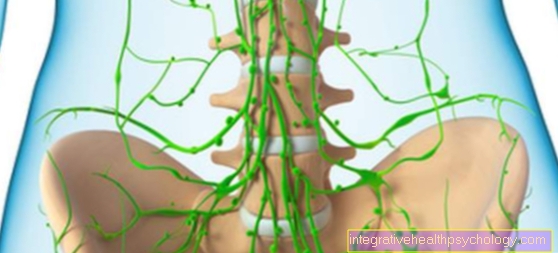Thrombocytosis
definition
Thrombocytosis is when the number of platelets, i.e. platelets, in the blood is increased. With thrombocytosis, there are more than 500,000 platelets per microliter in the blood. The platelets are responsible for blood clotting. They ensure that the wound closes again after an injury by forming a clot of blood. When there are too many platelets, as is the case with thrombocytosis, blood clots can occur and complications can result.
There are two different types of thrombocytosis. The reactive (secondary) thrombocytosis refers to a reaction to an underlying disease, whereas the essential (primary) thrombocytosis represents an independent disease.

Causes of Thrombocytosis
Thrombocytosis can either be a sequela of another underlying disease (secondary thrombocytosis) or an independent illness (primary thrombocytosis).
Primary thrombocytosis, also known as thrombocytemia, is a malfunction in the blood-forming system. This condition is genetically inherited and affects the bone marrow, which is where blood is made. It belongs to the malignant diseases.
However, secondary thrombocytosis is more common and can have various causes.
In the case of chronic inflammatory diseases, thrombocytosis can occur. These include, for example, rheumatic diseases or Crohn's disease. Acute infections or inflammations can also lead to an increase in the value.
Large blood loss, such as occurs during injuries or surgery, can also cause platelets to increase. Stomach ulcers, which are associated with profuse bleeding, can also be the trigger.
After surgical removal of the spleen (Splenectomy) the patient usually has thrombocytosis, as the spleen is responsible for breaking down blood platelets.
In addition, thrombocytosis is typical of chronic iron deficiency and can also be triggered by pregnancy, taking birth control pills or smoking.
In addition, competitive athletes can develop thrombocytosis as a result of the high level of physical activity.
Other possible causes are cancer and chemotherapy.
Thrombocytosis can also occur in healthy people. This can be caused by stress, anxiety or depression.
- This article may also be of interest to you: Too high platelets
Iron deficiency as a possible cause of thrombocytosis
Chronic iron deficiency is a possible cause of the development of thrombocytosis. Iron is needed by the body to make new red blood cells. Chronic iron deficiency therefore leads to anemia (anemia). In response, the production of platelets is stimulated. However, the exact mechanism has not yet been clarified.
Read more on the topic: Consequences of iron deficiency
Diagnosis of thrombocytosis
Thrombocytosis can be determined by a blood test. From a value of 500,000 platelets per microliter one speaks of a thrombocytosis.
This finding is often an incidental finding, as the thrombocytosis often occurs without symptoms. If an increase in platelets is detected, it should be clarified where it is coming from. Usually it is infection, inflammation or injury. A possible iron deficiency can also be detected by a blood test.
The blood values should be checked regularly in patients in whom a permanently elevated platelet value is to be expected, such as in cancer patients during or after chemotherapy.
However, if no cause can be found, one should be contacted primary thrombocytosis thought and a bone marrow aspiration performed. However, this is rarely necessary.
Symptoms of thrombocytosis
In most cases, thrombocytosis is symptom-free if it is a reaction to another illness or to surgery. This is because the increased number of platelets only lasts for a short time. If there is an increase in platelets during pregnancy or after exercise, there are often no symptoms because the increase is quite small.
However, if the thrombocytosis persists for a long time, various symptoms can occur. These are quite unspecific. These include, for example, visual disturbances, nosebleeds, bleeding gums, calf cramps, dizziness or headaches.
Is it a primary thrombocytosis so circulatory disorders occur. These are particularly noticeable in gait disorders and visual disorders. The increased number of platelets can lead to thrombosis and the risk of a heart attack or stroke is increased.
Read more on the topic: Causes of Thrombosis
Thrombocytosis in the child
As in adults, thrombocytosis occurs in children after injuries, surgery, or infections such as pneumonia or meningitis. In all of these cases, it is important to treat the underlying disease, after which the number of blood platelets normalizes itself again.
Iron deficiency is also a possible cause in children, in which case taking iron supplements can help reduce the number of platelets again. Chronic inflammation can also be present in children, causing symptoms similar to adults and the cause of thrombocytosis. In addition, increased stress or anxiety can lead to an increase in platelets in a healthy child.
A less common cause is anemia (anemia), which leads to an increase in blood platelets.
Primary thrombocytosis due to a malignant disease of the bone marrow can also be present in children. If this is diagnosed, therapy should be started immediately. Depending on the extent of the disease, this can be caused by the administration of blood-thinning medication (aspirin) range to chemotherapy.
Thrombocytosis in cancer
In the context of cancer, there is usually an increase in platelets. This is a sign that the body is taking action against the cancer and is trying to fight it. A corresponding increase in the value is to be expected, especially in the context of chemotherapy.
Read more on the topic: Chemotherapy side effects
Thrombocytosis after surgery
After an operation there is often an increase in platelets in the blood. The platelets are responsible for blood clotting. They ensure that wounds are closed by causing a blood clot to form. Since a more or less large wound occurs with every operation, more work is required for the blood platelets.
Not only the area where the skin was cut requires hemostasis and tissue repair, but also the internal wounds, which vary in size depending on the operation.
Thrombocytosis after an operation is completely normal and only shows that the body is reacting to external stimuli. With larger interventions, the platelet count in the blood increases more than with smaller interventions.
Therapy of thrombocytosis
Since thrombocytosis is often based on harmless causes, it usually does not require any special therapy and the platelet count normalizes itself again.
This applies, for example, to an increased value due to increased physical stress. Thrombocytosis is also often an incidental finding during pregnancy, as it does not cause any symptoms. As a rule, it is due to an iron deficiency and therapy with an iron preparation leads to the normalization of the platelet count.
In the event of an infection or inflammation, the underlying disease should be treated and then the number of blood platelets should be reduced. Since thrombocytosis increases the risk of thrombosis, it is important that the doctor prescribes the use of a drug to thin the blood in patients at risk.
Is there a primary thrombocytosis before, i.e. a malignant disease, an appropriate therapy must be started depending on the patient's risk. In young patients (under 60 years of age) who have no symptoms and who have comparatively high platelet counts, regular check-ups and the wearing of thrombosis stockings are sufficient.
Lots of exercise and weight loss are also recommended. If the patient also has a cardiovascular disease or an increased risk of thrombosis, blood-thinning medication should be started.
Chemotherapy should be initiated in patients over 60 years old who have severe bleeding or very high platelet counts (more than 1.5 million per microliter).
Read more on the topic: blood thinner
Thrombocytosis after splenectomy
Often there is one Splenectomy, i.e. surgical removal of the spleen, the cause of an increase in the platelet count in the blood.
The spleen is responsible for the “moulting of the blood”. It eliminates old or damaged blood cells from the bloodstream and breaks them down. The blood platelets are also subject to this regulation. If the spleen is now removed, fewer blood platelets are broken down and there is an increased number in the blood.
In addition, the production of blood platelets is stimulated by the operation and also leads to an increase. One to two weeks after the procedure, the concentration of platelets can be up to 1 million per microliter.
The value goes down by itself after a while, but there is still a slight increase in the platelet count.
Read more on the topic: Splenectomy - these are the consequences





























